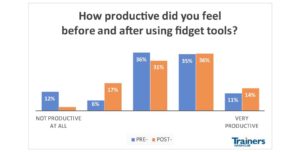Do fidgets boost engagement?
Prestige Worldwide, a consulting team of Suffolk University business students, set out to understand the impact of using fidget tools in classroom and workplace environments. They conducted surveys before and after introducing fidget tools into learning environments, asking 119 students in 2 classes about their experiences of engagement, productivity, and stress.
Engagement
Regarding the first questions, How engaged were you during class?, they report:
In the pre-survey, before anyone was introduced to or given a fidget tool, 14.4% of students indicated being ‘not at all engaged.’ After being given a fidget tool to use during class, this value dropped dramatically to 1.1%. On the opposite end of the spectrum, those who claimed they were ‘very engaged’ increased 103.3% (from 9% to 18.3%), when using fidget tool in class.
 Productivity
Productivity
The team next asked, “How productive were you during class?”
Similarly to the engagement question, the number of students reporting that they were unproductive dropped considerably, from 11.7% to 2.2% when using a fidget toy.
Stress
In the third and final survey question, participants were asked about their experience in feeling stressed during class. Fortunately for the students at Suffolk, the classroom experience is not deemed to be stressful. Consequently, no results are pertinent.
Conclusions
The group complemented their primary research with secondary research conducted at schools and universities. In doing so, they learned of a sixth grade class consisting of 29 students, who explored the impact of using stress balls during class. In that study, 10% of the students realized significant increases in test scores. Moreover, a stunning 47% of the students were reported to be less distracted during class(1). Evidence for the effectiveness of using fidget toys to improve focus, engagement and productivity continues to abound.
(1) Trade Journal: Stalvey, S., Brasell, H. Journal of At Risk Issues Vol 12 #2; (2006) Article: Using Stress Balls to Focus the Attention of Sixth Graders (2006, August) Retrieved from https://files.eric.ed.gov/fulltext/EJ853381.pdf
Find the best fidget toys for you.
Explore more data showing meeting attendees’ preference for toys.


1 thought on “Do fidgets boost engagement?”